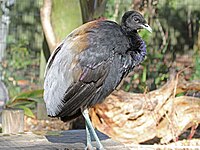
Psophia is a genus of birds restricted to the humid forests of the Amazon and Guiana Shield in South America. It is the only genus in the family Psophiidae. Birds in the genus are commonly known as trumpeters, due to the trumpeting or cackling threat call of the males. The three species resemble slightly taller, longer-legged chickens in size and appearance; they measure 45 to 52 centimetres long and weigh 1 to 1.5 kg. They are rotund birds with long, flexible necks and legs, downward-curving bills and a “hunched” appearance. Their heads are small, but their eyes are relatively large, making them look inquisitive and "good-natured". The plumage is soft, resembling fur or velvet on the head and neck. It is mostly black, with purple, green, or bronze iridescence, particularly on the wing coverts and the lower neck. In the best-known taxa, the secondary and tertial flight feathers are white, grey, or greenish-black and hairlike, falling over the lower back, which is the same colour. These colours give the three generally accepted species their names.

The band-rumped swift is a species of bird in subfamily Apodinae of the swift family Apodidae. It is found from Panama south through Colombia into Ecuador, east from Venezuela into the Guianas and Brazil, and on Trinidad.

The grey-rumped swift or gray-rumped swift is a species of bird in subfamily Apodinae of the swift family Apodidae. It is found in Honduras, Nicaragua, Costa Rica, and Panama; in every mainland South American country except Chile, French Guiana, Suriname, and Uruguay; in Trinidad and Tobago; and on Grenada.

Chapman's swift is a species of bird in subfamily Apodinae of the swift family Apodidae. It is found in Bolivia, Brazil, Colombia, French Guiana, Guyana, Panama, Peru, Suriname, Trinidad, Venezuela, and possibly Ecuador.
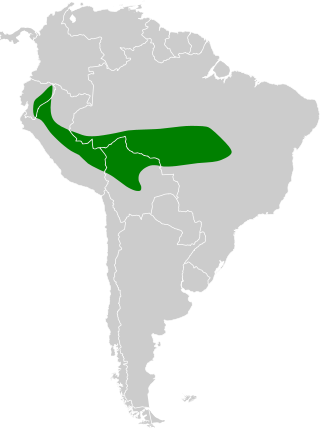
The pale-rumped swift is a species of bird in subfamily Apodinae of the swift family Apodidae. It is found in Bolivia, Brazil, Colombia, Ecuador, and Peru.
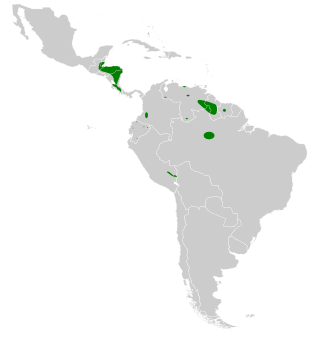
The white-chinned swift is a species of swift in the family Apodidae. It is found from Mexico south through most Central America countries into South America as far south as Peru and east as far as Suriname.

The spot-winged pigeon is a species of bird in the family Columbidae. It is found in Argentina, Bolivia, Brazil, Chile, Paraguay, Peru, and Uruguay.

The pale-winged trumpeter, also known as the white-winged trumpeter, is a Near Threatened species of bird in the family Psophiidae. It is found in the western Amazon rainforest of Bolivia, Brazil, and Peru.

The dark-winged trumpeter is a species of bird in the family Psophiidae. It is endemic to Brazil.

The ochre-throated foliage-gleaner is a species of bird in the Furnariinae subfamily of the ovenbird family Furnariidae. It is found in Panama and every mainland South American country except Argentina, Chile, Paraguay, and Uruguay.

The red-billed woodcreeper is a species of bird in the subfamily Dendrocolaptinae of the ovenbird family Furnariidae. It is found in Brazil, French Guiana, Guyana, Suriname, and Venezuela.

The wing-banded antbird is a species of passerine bird in subfamily Myrmornithinae of family Thamnophilidae, the "typical antbirds". It is found in Brazil, Colombia, Ecuador, French Guiana, Guyana, Nicaragua, Panama, Peru, Suriname, and Venezuela.

The ruddy spinetail is a species of bird in the Furnariinae subfamily of the ovenbird family Furnariidae. It is found in Bolivia, Brazil, Colombia, Ecuador, Guyana, Peru, Suriname, Venezuela, and possibly Guyana.

The ochre-cheeked spinetail is a species of bird in the Furnariinae subfamily of the ovenbird family Furnariidae. It is found in Argentina, Bolivia, Brazil, Paraguay, and Peru.

The ocellated woodcreeper is a species of bird in the subfamily Dendrocolaptinae of the ovenbird family Furnariidae. It is found in Bolivia, Brazil, Colombia, Ecuador, Peru, and Venezuela.
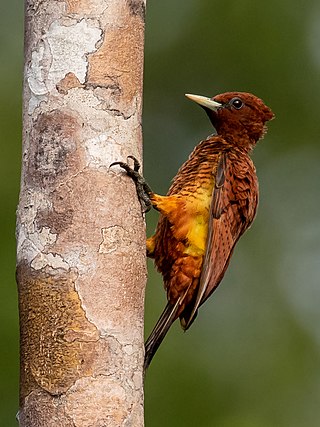
The scaly-breasted woodpecker, also known as the scale-breasted woodpecker, is a subspecies of bird in subfamily Picinae of the woodpecker family Picidae. Some taxonomists consider it a separate species. It is found in Bolivia, Brazil, Colombia, Ecuador, Peru, and Venezuela.

The waved woodpecker is a species of bird in subfamily Picinae of the woodpecker family Picidae. It is found in Bolivia, Brazil, Colombia, Ecuador, French Guiana, Guyana, Peru, Suriname, and Venezuela.

The lettered aracari or lettered araçari is a near-passerine bird in the toucan family Ramphastidae. It is found in Bolivia, Brazil, Colombia, Ecuador, and Peru.
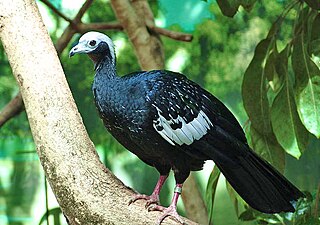
The blue-throated piping guan is a species of bird in subfamily Penelopina of family Cracidae, the guans, chachalacas, and curassows. It is found in Bolivia, Brazil, Colombia, Ecuador, the Guianas, Peru, and Venezuela.

Tschudi's woodcreeper is a passerine bird native to South America. It belongs to the genus Xiphorhynchus in the woodcreeper subfamily, Dendrocolaptinae. It is usually regarded as a subspecies of the ocellated woodcreeper. It is named after Johann Jakob von Tschudi, the Swiss explorer and naturalist who first described the bird.




